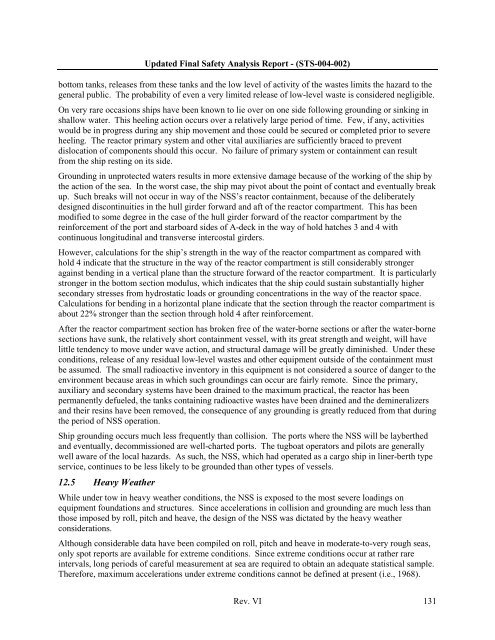10 CFR 50.71(e) - Maritime Administration - U.S. Department of ...
10 CFR 50.71(e) - Maritime Administration - U.S. Department of ...
10 CFR 50.71(e) - Maritime Administration - U.S. Department of ...
Create successful ePaper yourself
Turn your PDF publications into a flip-book with our unique Google optimized e-Paper software.
Updated Final Safety Analysis Report - (STS-004-002)bottom tanks, releases from these tanks and the low level <strong>of</strong> activity <strong>of</strong> the wastes limits the hazard to thegeneral public. The probability <strong>of</strong> even a very limited release <strong>of</strong> low-level waste is considered negligible.On very rare occasions ships have been known to lie over on one side following grounding or sinking inshallow water. This heeling action occurs over a relatively large period <strong>of</strong> time. Few, if any, activitieswould be in progress during any ship movement and those could be secured or completed prior to severeheeling. The reactor primary system and other vital auxiliaries are sufficiently braced to preventdislocation <strong>of</strong> components should this occur. No failure <strong>of</strong> primary system or containment can resultfrom the ship resting on its side.Grounding in unprotected waters results in more extensive damage because <strong>of</strong> the working <strong>of</strong> the ship bythe action <strong>of</strong> the sea. In the worst case, the ship may pivot about the point <strong>of</strong> contact and eventually breakup. Such breaks will not occur in way <strong>of</strong> the NSS’s reactor containment, because <strong>of</strong> the deliberatelydesigned discontinuities in the hull girder forward and aft <strong>of</strong> the reactor compartment. This has beenmodified to some degree in the case <strong>of</strong> the hull girder forward <strong>of</strong> the reactor compartment by thereinforcement <strong>of</strong> the port and starboard sides <strong>of</strong> A-deck in the way <strong>of</strong> hold hatches 3 and 4 withcontinuous longitudinal and transverse intercostal girders.However, calculations for the ship’s strength in the way <strong>of</strong> the reactor compartment as compared withhold 4 indicate that the structure in the way <strong>of</strong> the reactor compartment is still considerably strongeragainst bending in a vertical plane than the structure forward <strong>of</strong> the reactor compartment. It is particularlystronger in the bottom section modulus, which indicates that the ship could sustain substantially highersecondary stresses from hydrostatic loads or grounding concentrations in the way <strong>of</strong> the reactor space.Calculations for bending in a horizontal plane indicate that the section through the reactor compartment isabout 22% stronger than the section through hold 4 after reinforcement.After the reactor compartment section has broken free <strong>of</strong> the water-borne sections or after the water-bornesections have sunk, the relatively short containment vessel, with its great strength and weight, will havelittle tendency to move under wave action, and structural damage will be greatly diminished. Under theseconditions, release <strong>of</strong> any residual low-level wastes and other equipment outside <strong>of</strong> the containment mustbe assumed. The small radioactive inventory in this equipment is not considered a source <strong>of</strong> danger to theenvironment because areas in which such groundings can occur are fairly remote. Since the primary,auxiliary and secondary systems have been drained to the maximum practical, the reactor has beenpermanently defueled, the tanks containing radioactive wastes have been drained and the demineralizersand their resins have been removed, the consequence <strong>of</strong> any grounding is greatly reduced from that duringthe period <strong>of</strong> NSS operation.Ship grounding occurs much less frequently than collision. The ports where the NSS will be layberthedand eventually, decommissioned are well-charted ports. The tugboat operators and pilots are generallywell aware <strong>of</strong> the local hazards. As such, the NSS, which had operated as a cargo ship in liner-berth typeservice, continues to be less likely to be grounded than other types <strong>of</strong> vessels.12.5 Heavy WeatherWhile under tow in heavy weather conditions, the NSS is exposed to the most severe loadings onequipment foundations and structures. Since accelerations in collision and grounding are much less thanthose imposed by roll, pitch and heave, the design <strong>of</strong> the NSS was dictated by the heavy weatherconsiderations.Although considerable data have been compiled on roll, pitch and heave in moderate-to-very rough seas,only spot reports are available for extreme conditions. Since extreme conditions occur at rather rareintervals, long periods <strong>of</strong> careful measurement at sea are required to obtain an adequate statistical sample.Therefore, maximum accelerations under extreme conditions cannot be defined at present (i.e., 1968).Rev. VI 131
















